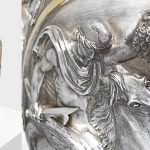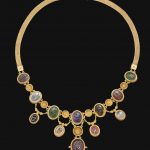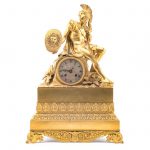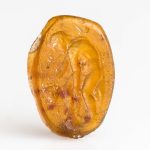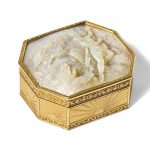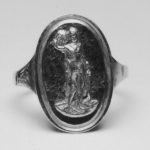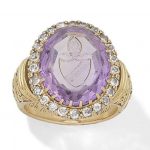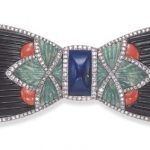Information on Perseus, the Greek hero who slayed Medusa. In Greek mythology, Perseus is the legendary founder of Mycenae and of the Perseid dynasty, who, alongside Cadmus and Bellerophon, was the greatest Greek hero and slayer of monsters before the days of Heracles. He beheaded the Gorgon Medusa for Polydectes and saved Andromeda from the sea monster Cetus. He was the son of Zeus and the mortal Danaë, as well as the half-brother and great-grandfather of Heracles. Reference: Wikipedia
Perseus is often portrayed in cameos with the head of Medusa or with Andromeda.
An impressive Victorian parcel-gilt silver cup and cover by Hancocks & Co, London 1872 Vase form, the cover surmounted by the figure of Nike, the two handles supported by twin-tailed mermaids, the body with two cameo scenes, the first of Perseus rescuing Andromeda, the other of the foundation of Athens with Athena and the olive tree and Neptune creating a spring by thrusting his trident into the ground, the whole richly embossed and chased with floral and foliate ornament, length 86.5cm, weight 236oz.
Sold for £ 22,500 inc. premium at Bonhams in 2018
A NECKLACE OF TWELVE ROMAN RINGSTONES CIRCA 1ST CENTURY B.C.-2ND CENTURY A.D. Mounted together in a Victorian gold setting, including, top row, left to right: a carnelian with Neptune holding a trident and a dolphin; a chalcedony with Mercury stepping onto a ship’s prow, holding his caduceus; a plasma with Perseus leaning on an altar, holding the decapitated head of Medusa; an amethyst with Dionysus standing below a grape arbor, pouring from an oinochoe, holding his thyrsus, a quadruped beside him; a citrine(?) with the Muse Thalia seated on an altar, holding a pedum and a comic theater mask; a carnelian with Bonus Eventus standing nude, holding two sheafs of wheat and a phiale; and a plasma with Venus standing, nude but for a mantle falling over her shoulders, opening a box raised up in her hands, a vase and a palm branch before her; second row, left to right: a carnelian with a helmeted male head in profile to the left; a carnelian with a portrait head of Socrates in profile to the left; a carnelian with a head of Ceres in profile to the right; and a banded agate with a head of Jupiter in profile to the right; the central pendant a garnet with Hercules kneeling, his club raised, a Cupid on his shoulder Largest stone: 5/8 in. (1.6 cm.) long; Necklace: 14 in. (35.6 cm.) long
Sold for USD 16,250 at Christies in 2008
French bronze dore figural mantel clock rectangular plinth base on scrolling foot, surmounted with a figure of Perseus holding shield with head of Medusa, incorporating a clock, dial with Roman numerals, 19 3/4 in. H., 13 1/4 in. W., 5 in. D.
Sold for $2,000 at Alex Cooper in 2017
Oval gem with Perseus holding head of Medusa Roman Imperial Period 1st century A.D.
Light brown glass. Intaglio. Perseus, facing left, bends forward and holds the head of Medusa in his left hand and a sword in the right. He steps on an orb/circle/rock with his left foot. He wears a chlamys tied at the neck that flows down his back. Across his forehead, a series of three pellets to indicate hair. Head of Medusa shows frontal, with flat, wide nose.
Reference: Museum of Fine Arts Boston
A gold and mother of pearl snuff box of cut-cornered rectangular form, the gold sides with sunray engine-turned panels, the borders chased with scrolling foliage on matted ground, Johann George Aigner, Vienna, 1800, set with later mother of pearl panels, the lid carved with Perseus and Andromeda 6.7cm., 2 5/8 in. wide
Sold for 6,000 GBP at Sothebys in 2016
Ring with Perseus – This ring copies a well-known ancient depiction of the hero Perseus, shown in his moment of triumph over Medusa, one of the Gorgons, whose gaze turned onlookers into stone. Perseus holds his sword in his right hand, while raising Medusa’s head high with his left. The technique- gold relief on an iron background- was used as an alternative to intaglios in the later 18th century.
Reference: The Walter Art Museum
